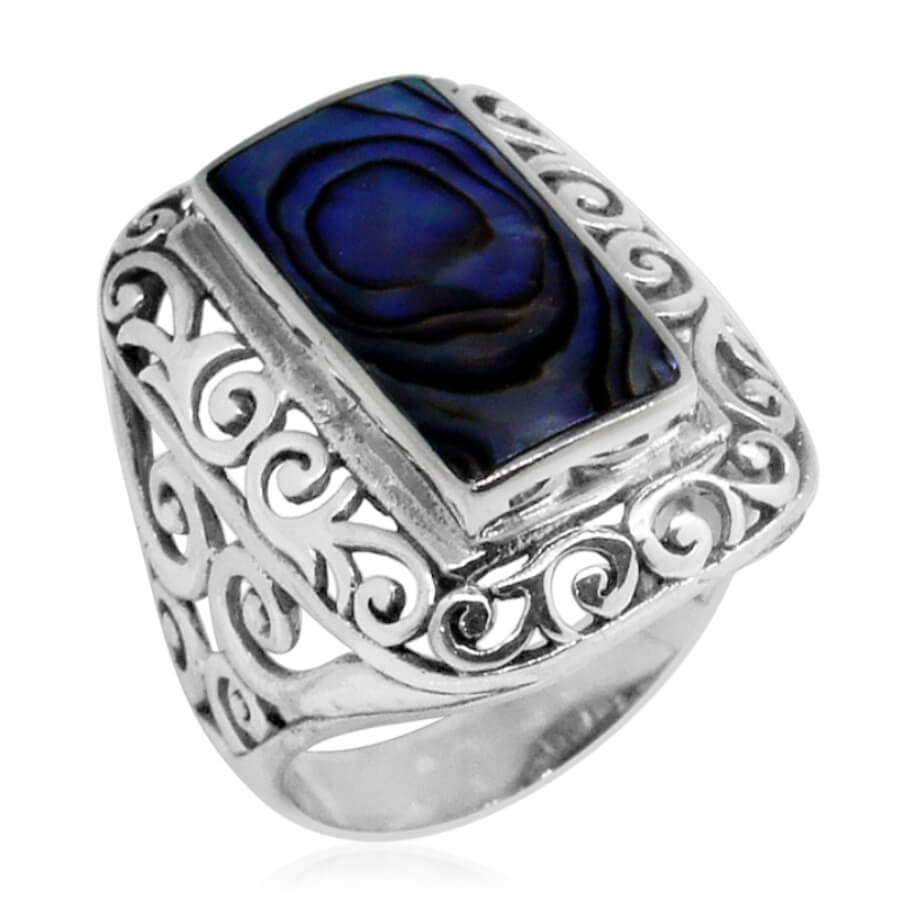WHAT IS ABALONE SHELL?
Abalone shell is an organic gem that shows iridescent blues, greens, and purples. Shell jewelry is some of the oldest known decorations used by early humans. The first humans began a tradition of craftsmanship that has been perfected over the centuries.

The word abalone comes from the American Spanish word abulón. It is a borrowed word. The Rumsen is a Native American group around Monterey Bay, California, and abalone is known as aulon in their language. The earliest use of abalone can be traced to the mid-19th century in California.
In New Zealand, abalone is known as pāua, a Maori word for the mollusk.
Determining Abalone Shell Value
Is abalone shell valuable? The value of colored stones is determined by a combination of color, clarity, cut, and carat weight. This is no different when determining what abalone shell is worth. These guidelines will help you choose abalone shell for your collection.
- Abalone Shell Color
Abalone shell occurs in a variety of iridescent colors. The primary range consists of moody blues, mysterious greens, and royal purples. Shells can potentially be nearly any color of the rainbow. Despite this, blues, greens, and purples remain the most common and widespread.
- Abalone Shell Clarity
Abalone shell is a translucent-opaque gemstone. The surface of the shell should be smooth after polishing, and free from blemishes. Rough spots, nicks, and chips can all lower its value. Shells take on a glossy luster after polishing.
- Abalone Shell Cut
Abalone shell is cut in specific shapes. Common forms include round, oval, marquise, and pear. This gemstone is specially cut to be big and colorful.
- Abalone Shell Carat
The size of abalone shell at Shop LC can be up to a couple of inches wide. These sizes can weigh up to 28 carats. The price per carat tends to increase with larger stones as they are more challenging to produce in one continuous piece.
Abalone Shell Treatment
This stone undergoes no known treatment.
Caring for Abalone Shell
Abalone shell ranks 3.5 on the Mohs scale of hardness. Despite being susceptible to scratches and abrasions, abalone shell is durable and has fair toughness. Avoid harsh household chemicals and prolonged exposure to direct sunlight with this gem. Do not use ultrasonic or steam cleaners as it may cause permanent damage.
For regular cleaning, use warm, soapy water and a soft-bristled brush. After scrubbing, rinse the gemstone in clean water to remove all soapy residue. Wipe the gem with a soft cloth to dry.
Wrap your shell jewelry in a soft cloth before storing them inside a fabric-lined storage box. Proper care of abalone shell jewelry extends its life for years of enjoyment.
Who Can Wear Abalone Shell?
The beauty of abalone shell jewelry is a romantic reminder for lovers of the sea and ocean. It is an ideal choice for someone who wants to feel a special connection to the Earth.
Abalone shell displays a rich color-play that showcases greens and blues to violet shades. The gemstone matches brilliantly with any metal, but especially with yellow gold and rose gold for a vintage look. Its peacock tones make it perfect for boho-themed jewelry as well as contemporary, sophisticated styles.
Its striking hues make abalone shell an ideal choice for minimalist jewelry. In contrast, abalone work looks terrific in large statement jewelry too!
How Does Abalone Shell Compare to Other Stones?
We prize abalone shell for its range of moody blues, mysterious greens, and royal purples. The shell shows strong iridescence, also known as orient.
If you love pearl or gems like labradorite, abalone shell is a great addition to your collection.
Where Does Abalone Shell Come From?
AShop LC sources ethically produced abalone from Australia, China, Japan, New Zealand, and Taiwan. The mollusk favors the colder waters surrounding these areas. These countries use aquaculture programs to raise abalone as a food source.
How is Abalone Shell Mined?
Abalone harvesting occurs in three to five-year cycles, depending on the species. The best stock is used for spawning, and their microscopic eggs are collected to create the next generation. The water containing eggs is collected and placed in special hatching tanks. Under carefully controlled conditions, the abalone larvae are carefully nurtured for a year. To begin, they are fed a diet of algae or seaweed. As the mollusks approach maturity, the abalone will start to feast on kelp.
Once the young abalone are past this vulnerable stage, they are transferred to their final home. For the next few years, they will continue to grow. Once the abalones have reached full-size, the mollusks ready for harvest.
Alternately, some fisheries will seed reefs with young abalone for later harvest. For instance, Japan has been very successful with this method, as many farms are individually owned, and the process is subsidized. After seeding, the abalone is left to fend for themselves until they reach maturity and are suitable for harvest.
Abalone Shell Properties
What Does Abalone Shell Mean?
Gem therapists believe that abalone shell enhances the feelings of peace, beauty, compassion, and love. The shell is said to gently open-up the psychic and intuitive connections of the wearer. It emphasizes communication, collaboration, commitment, and cooperation - which results in harmony and balance.
Disclaimer: For informational purposes only. These remedies, approaches, and techniques are not a substitute for professional medical care or treatment. They should not be used to treat any ailment without prior consultation with a qualified health care professional.
Is Abalone Shell a Birthstone?
Abalone shell is not a modern birthstone. However, its rainbow colors and iridescence make it a favorite among jewelry enthusiasts!
Abalone Shell Facts
- Abalone Shell ranks 3.5 on the Mohs scale of hardness
- Abalone Shell displays hues of blues, greens, and purples.
- Shop LC sources our supply from Australia, China, Japan, New Zealand, and Taiwan.
- Abalone Shell does not undergo any known treatment.
- Abalone Shell is also known as Paua Shell.




